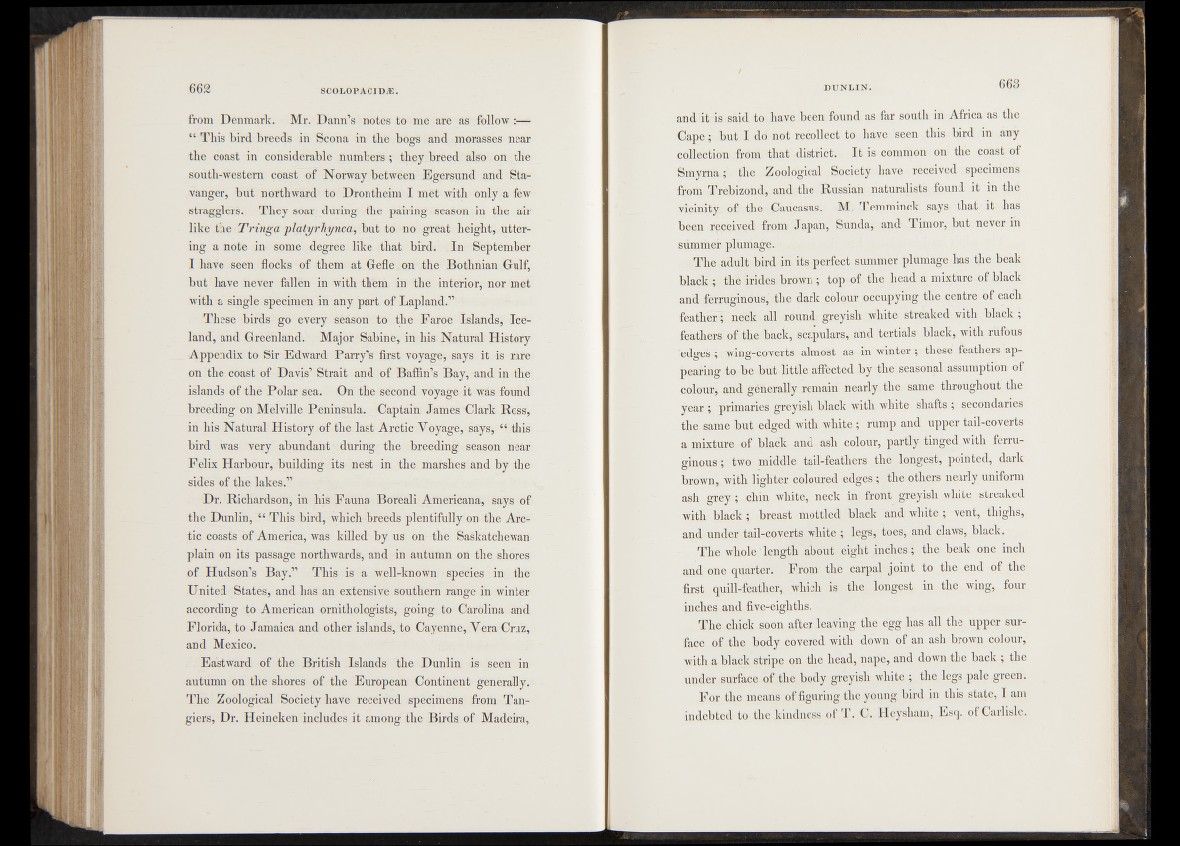
from Denmark. Mr. Dann’s notes to me are as fellow :—
“ This bird breeds in Scona in the bogs and morasses near
the coast in considerable numbers ; they.breed also on the
south-western coast of Norway between Egersund arid Stavanger,
but northward to Drontheim I met with only a few
stragglers. They soar during the pairing . season in the air
like the Tringa platyrhynca, :but to mo gréât height, uttering
a note in some degree like that bird/ .In September
I have seen flocks of them at Gefle ^on the Bothhian Gulf,
but have never feilen in with th'em in the interior, nor met
with a single specimen in . any part of Lapland.” '
These birds go every season to the Faroe Islands, Iceland,
and Greenland. Major Sabine, in his Natural History
Appendix-to Sir Edward Parry’s first voyage,, says if fife rkre
on the coast of Davis’ Strait and of Baffin’s Bay, and in the
islands óf the Polar sea. On the second voyage it was found
breeding on Melville Peninsula. Captain. James Olark Ross,
in his Natural History of the last Arctic Voyagé, says, “ this
bird was very abundant; during the breeding season near
Felix Harbour, building its nest in the marshes and by the
sides of the lakes.”
Dr. Richardson, in his Fauna Boreali Americana, ■ says of
the Dunlin, “ This bird, which breeds plentifully on 4he Arctic
coasts of America, was killed by us on the Saskatchewan
plain on its passage northwards, and in autumn on the shores
óf Hudson’s Bay.” This is a well-known species in thé
United States, and has an extensivè southern range in winter
according to American ornithologists, going, to Carolina and
Florida, to Jamaica and other islands, to Cayenne, Vera Cruz,
and Mexico.
Eastward of the British Islands the Dunlin is seen in
autumn on the shores of the European Continent generally.-
The Zoological Society have received spécimens from Tan-
giers, Dr. Heineken includes it among the Birds of Madeira,
and it'is said to have been found as far south in Africa as the
Cape; but I dor not recollect to have/seen this bird in any
collection .front'that district. I t is common , on the coast of
Smyrna % the Zoological Society, have received specimens
from Trebizpnd, ,an43S;%ie^ Russian ,naturalists found it in the
vicinity: the Caucasus: M. Temminck sayafithat it has
begn received from Japan, Sunda, and Timor, but never-in
summer pluniage.
The adult bird in its perfect summer plumage-has the beak
black ; the irides brown ; top of the head a mixture of black
and ferruginous, .the "dark colour occupying th^|centre of each
feather; neck all.round; greyish white streaked with black ;
feathers' of the bacl^ scapulars, and fert-ials blackj-withrufeus
edges ; wing-Coverts. almost as in winter ; these feathers ap-
pearing ,to;be but little'^affected-by the seasonal', assumption of
colour, and generally .remain n early .the-. safe©, throughout/the
year ; primaries greyish black with white, shafts ; secondaries
the same b j f edged with w-hit^f .rump and upper tail-coverts
a mixture,.-of black and ash colour, partly tingexljWith ferruginous*,';
rtwo middtetail-feathers the longest, pointed, dark
brown, with l^hter coloured edges .; the others nearly uniform
ash grey; chin white, neck in front greyish white streaked
with, bjack; breast mottled black and white; vent, thighs,
and under tail-coverts white.; legs, toes, and claws, black.
The whole‘length about eight inches'; the beak one inch
and one quarter. From the carpal joint to tljte^ end of the
first quill-feather,- which is the -longest in the wing,, four
inches a n d .five-eighths.
The chick soon after leaving the egg has all the upper surface
of the body covered with down of an ash brown colour,
with a black stripe on the head, nape, and down the back ; the
under surface of the body greyish ,whitq.;:L the legs pale green.
For the means of figuring the young bird in this state, I am
indebted to-the kindness of T. C. Heysham, Esq. of Carlisle.